#kazuma kaneko
Text

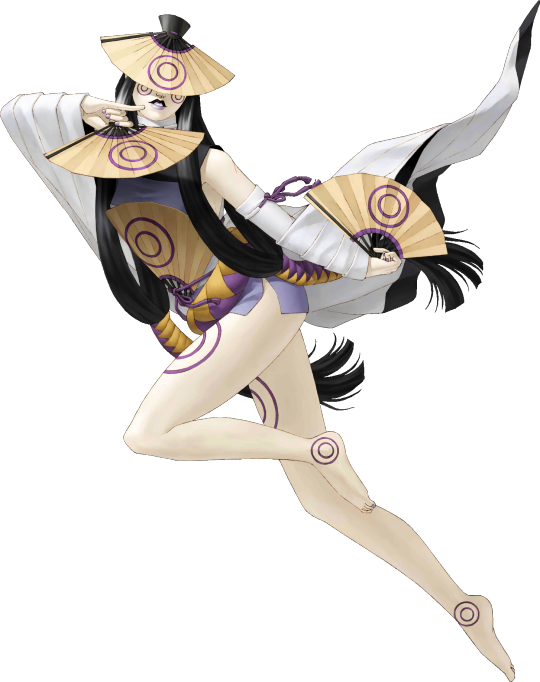

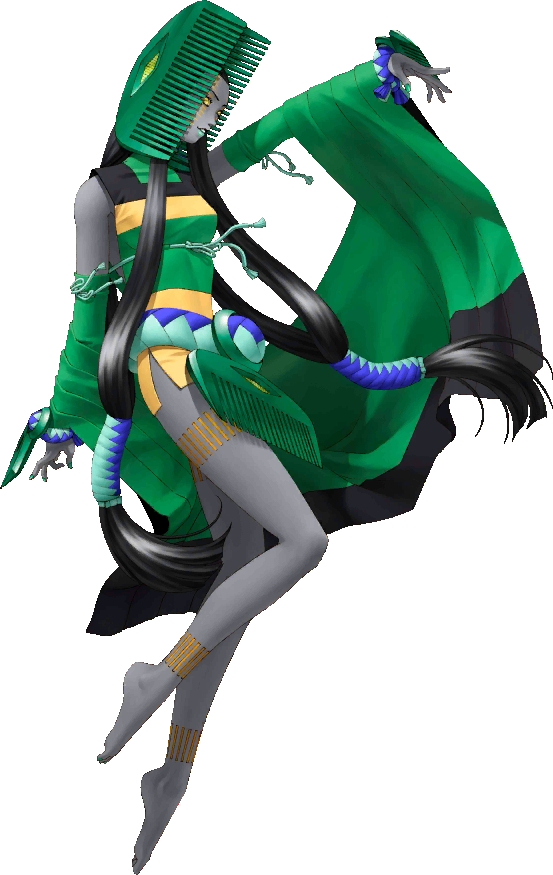
I'm impressed with how well Doi's new Konohana Sakuya harmonizes with Kaneko's existing Nocturne JP goddesses despite not being part of their exact same template.
I dare say the demons revealed for Vengeance thus far are some of Doi's best yet and may mark a turning point for him as a demon designer!
#smt5v#smtvv#smt5: vengeance#masayuki doi#megaten#smt#konohana sakuya#ame no uzume#kikuri-hime#kushinada-hime#kazuma kaneko#shin megami tensei#nocturne
30 notes
·
View notes
Text

How to make modern era Kaneko rendering
I use user-made CSP tools listed here :
- Lineart -> https://assets.clip-studio.com/en-us/detail?id=2060489 (Can use the brush used for coloring too. As long it's a textured pencil with high sensitivity. It'll works)
- Coloring -> https://assets.clip-studio.com/en-us/detail?id=1761353 - Blend -> https://assets.clip-studio.com/en-us/detail?id=1391024
- Scan Dot Effect -> https://assets.clip-studio.com/en-us/detail?id=1687175
- Color Filter -> https://assets.clip-studio.com/en-us/detail?id=1732272 (Set at clip layer > Difference)
Rendering tutorial below :
1. Prepare line art with rough textured pen. I used a pencil tool
2. Color in base. Idk I think Kaneko often starts from dark->light, but I too used with light->dark coloring.
3.) If you're coloring it light->dark like me. Slowly go from base color, to secondary, and put the darkest color on last. I use the pencil tool on my previous post
4.) blend the shading with watercolor tool. Be careful to not overblend it'll look glossy. Pull and push the color
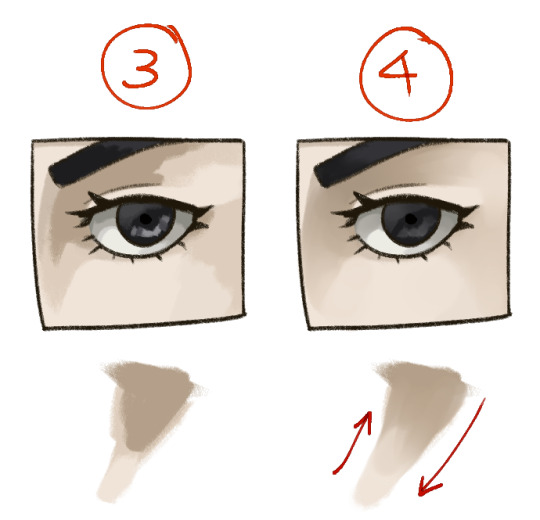
5.) at this point, you might want to process the line art a bit.
Idk what tool Kaneko used for the lineart in this era, but it's super textured and "fades" when you put low pressure, like a real pencil.
Interestingly enough, his modern art style would ditch the textured pen(?)

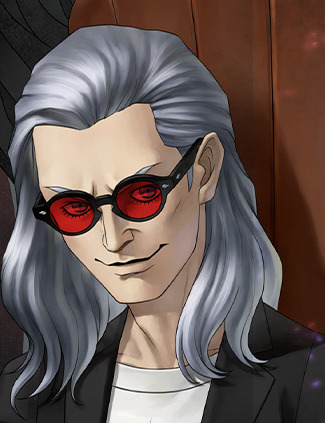
6.) For the eye highlights, I used a white layer with "add" layer effect.


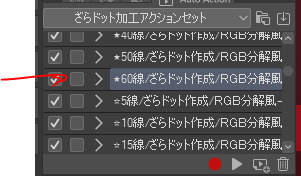
7.) Optional, but if you want the classic scan effect and color for parody/april fools project. You can use this filter from the user-made CSP filter list I posted above, set the folder to clipping layer -> difference + 50% opacity for the folder.
If you want to even add more, you can add the dot filter processing. For this pic I used 60 size dot because it's a small sized close up of an eye. For a gigantic pic you can use 10 or 15... Whatever you want
---
The result will look something like this. I think my lineart's too thick and I over-rendered too much on its clothes. If you learn from my failure, I think you can reproduce a parody of Kaneko's artwork, either for april fools purpose or maybe you wanna reverse engineer it into your own art style
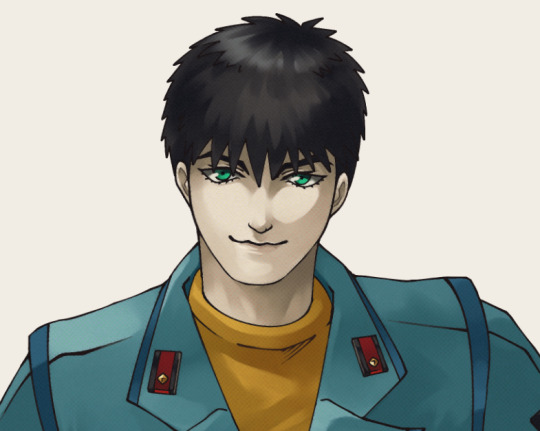

If you're wondering why Kaneko's art style had a distinct porcelain doll look, you might want to refer to this post of Kaneko and possible inspiration from 80s animator Tomonori Kogawa
255 notes
·
View notes
Photo

Kazuma Kaneko
347 notes
·
View notes
Text

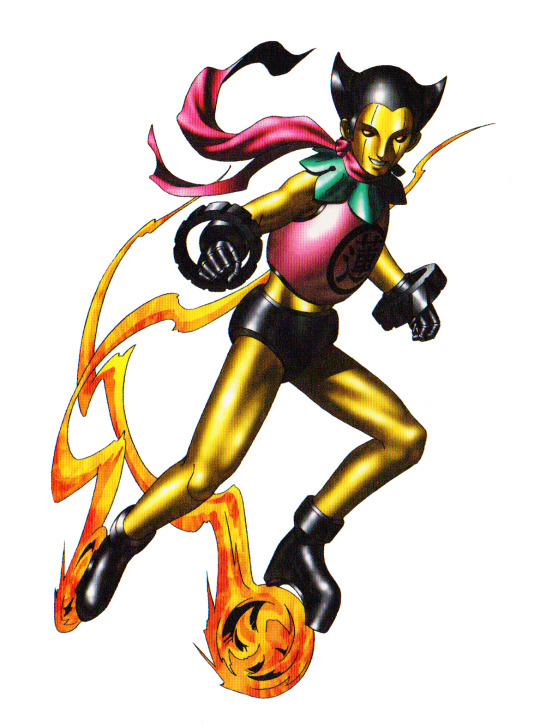



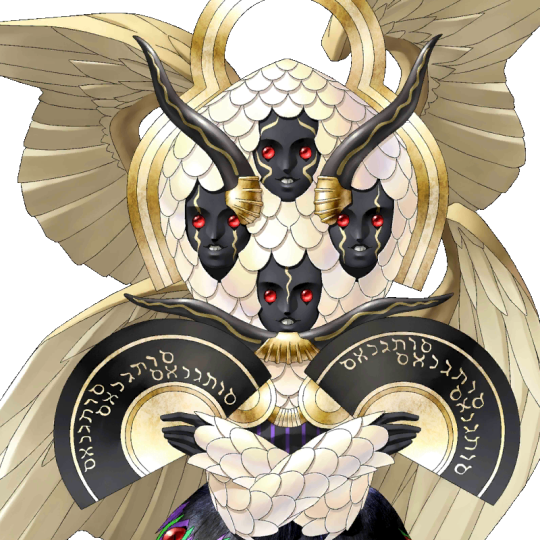

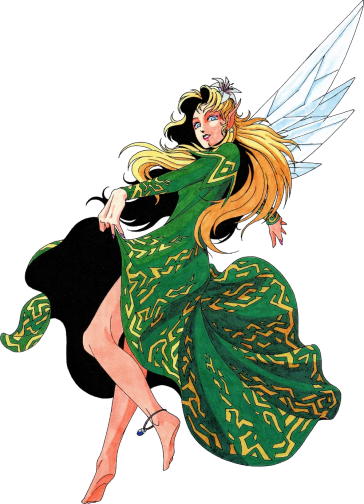
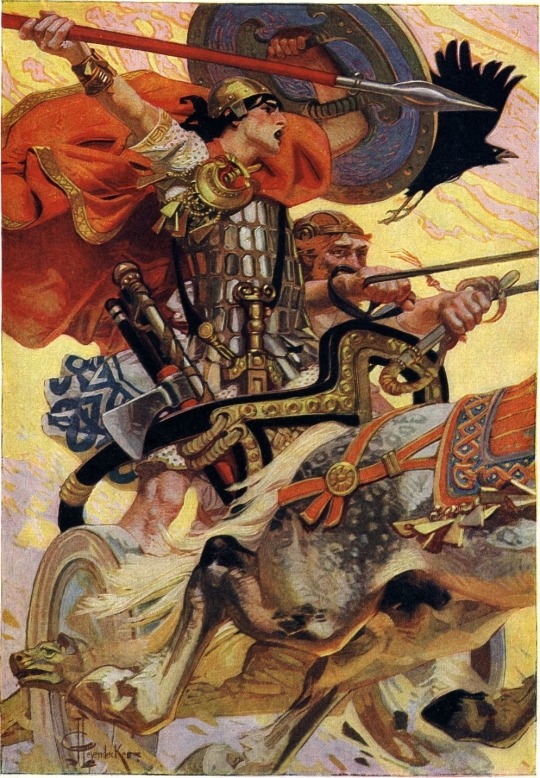

KANEKO’S CRIB NOTES LXV: SEVEN SEAS OF CRIBS
Halloween is on the approach, and what could this mean? Tricks, treats? Skeletons, witches, draculae? A child's laughter sounding lightly through the autumn leaves? No, it doesn't mean any of that GARBAGE- it's time for the annual outing of KANEKO'S CRIB NOTES! Please enjoy this smattering of delirious cribs that will make you think "damn, that's the thing that the other thing is based on".
NEZHA: The modern pop sensibility of Soul Hackers is on display in Nezha's Astro Boy inspired design, drawing a parallel between the two "rebuilt" child heroes. It's evident from the twin spikes and whatever the fuck that is, you know, his metallic underwear I suppose.
CHERUB: Following the probably erroneously designated 'Ophanim' from SMTII, and playing on Kaneko's documented fascination with angelkind as spacecraft, this Devil Summoner take on Cherub pushes the concept even further, borrowing a look from the cover of ancient alien classic The Spaceships of Ezekiel by Joseph F. Blumrich. Compare the cover to the Japanese edition that Kaneko was more likely familiar with!
SERAPH: The composition of Seraph's four heads and crossed arms is a likely homage to the iconic cover of 1974's Queen II. Slap that shit on your dorm room wall for a change!
TITANIA: Titania's appearance in SMTII is a slightly embellished take on this Brian Froud illustration of the ghostly Glaistig of Scotland. Thanks to Psiguy for originally sharing this ID from @yen_den, based on a post uploaded to the @theavalonians twitter account!
FIONN MAC CUMHAILL: In the spirit of equanimity, a last addition to the DOI'S CRIB NOTES series: Fionn Mac Cumhaill appears to be inspired by the dress of legendary illustrator J.C. Leyendecker's 'Cu Chulainn Riding His Chariot Into Battle' (1911), from the rectangular pattern of his mail-coat down to the telltale 'X' meander that runs along the fringe of either cloak.
#kaneko's crib notes#kazuma kaneko#nezha#fionn mac cumhaill#cherub#seraph#titania#astro boy#j.c. leyendecker#queen#brian froud#smt#megaten#devil summoner#persona#doi's crib notes#masayuki doi
298 notes
·
View notes
Text

HEARTBREAKING ANNOUNCEMENT: Kaneko is back and he's making art for a fucking NFT/blockchain game
392 notes
·
View notes
Text

Shin Megami Tensei III - Nocturne (2003)
Art by Kazuma Kaneko
197 notes
·
View notes
Text

Let the Butterflies Spread Until the Dawn
#persona#persona 1#megami ibunroku persona#maki sonomura#persona fanart#philemon#velvet room#kazuma kaneko
131 notes
·
View notes
Text

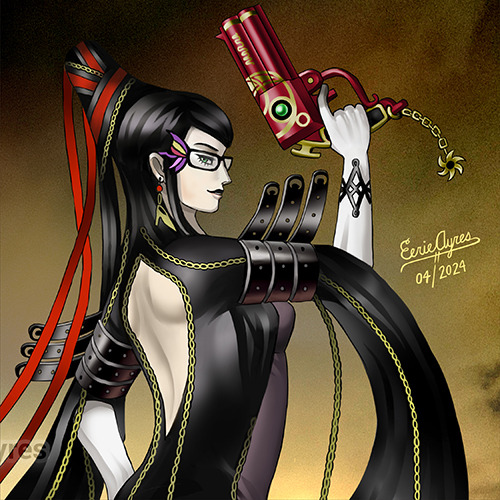

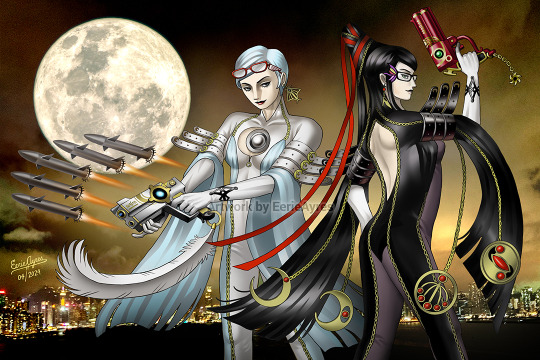
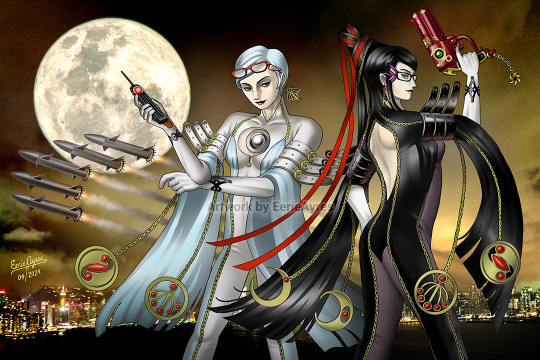
"I'm really beginning to hate missiles."
- Luka
My art of Bayonetta vs. Jeanne, inspired by the old-school Shin Megami Tensei art style of Kazuma Kaneko.
Thank you my 1.1k Twitter followers! Bayonetta was suggested by Ceredolce
Bayonetta © Platinum Games
Artwork © EerieAyres
#artists on tumblr#bayonetta#bayonetta 1#bayojeanne#kazuma kaneko#bayonetta fanart#jeanne fanart#cereza#jeanne#jeanne bayonetta#bayonetta jeanne#bayonetta cereza#platinum games#umbra witch#kaneko kazuma#shin megami tensei#megaten#art style#my art#digital art
76 notes
·
View notes
Text
I don't actively use Tumblr, so I'm a bit late to say it here, but R.I.P. Akira Toriyama. His passing is nothing short of a catastrophic loss, imo he genuinely had a strong argument for being one of the most influential artists alive. It feels surreal to think that in just two years, two of my three favorite mangaka are gone (R.I.P. Kazuki Takahashi), I thought those guys were gods when I was a kid I never even considered something could happen to them.
In his memory, here's some stuff about his influence on MegaTen. In Kazuma Kaneko Works I, Kaneko described Chaos Hero's design from the latter half of SMT1 as being reminiscent of Piccolo's outfit with the vibe of Goku. In specific, his hairstyle was said to have been explicitly based off of super saiyan.
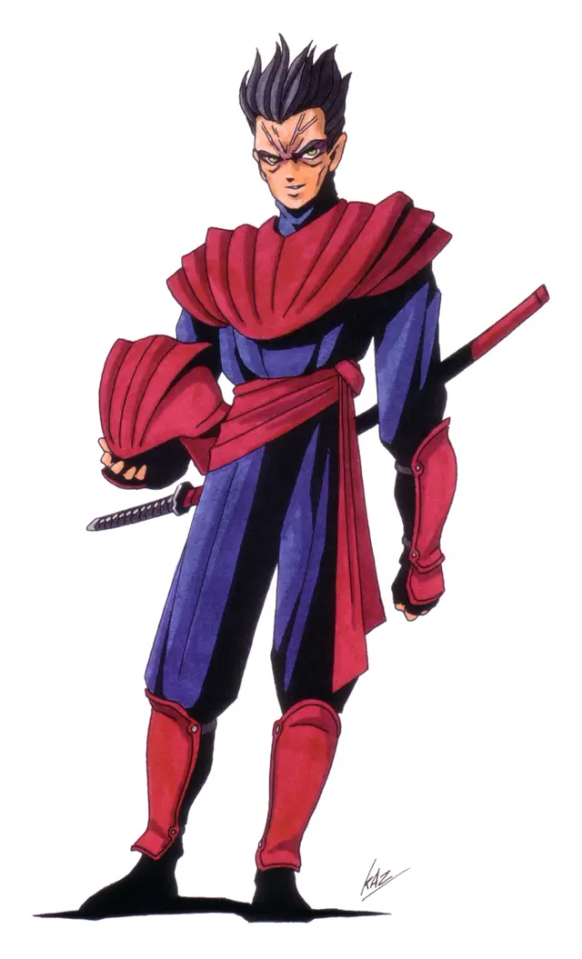

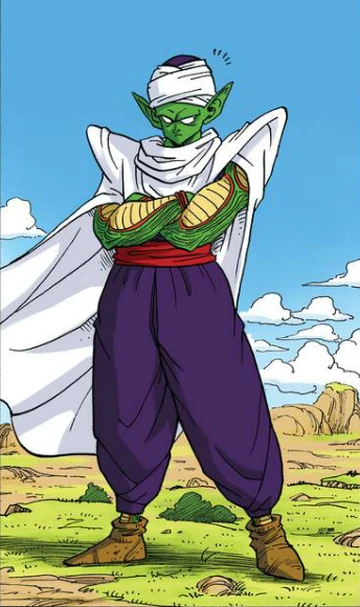
As for Dragon Quest, in Digital Devil Apocalypse, when asked about how he felt about cute designs, the first thing that came to Kaneko's mind was Slime. Kaneko even made this little comic about how he was frustrated trying to design a mascot as perfect as the Dragon Quest Slime.

131 notes
·
View notes
Text

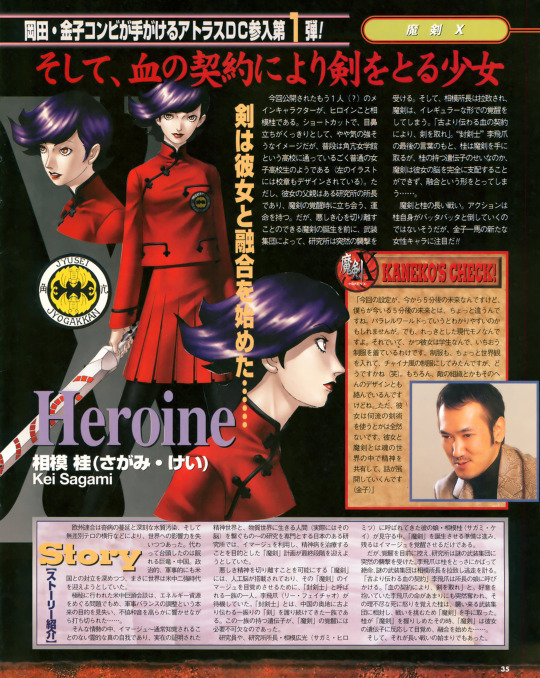



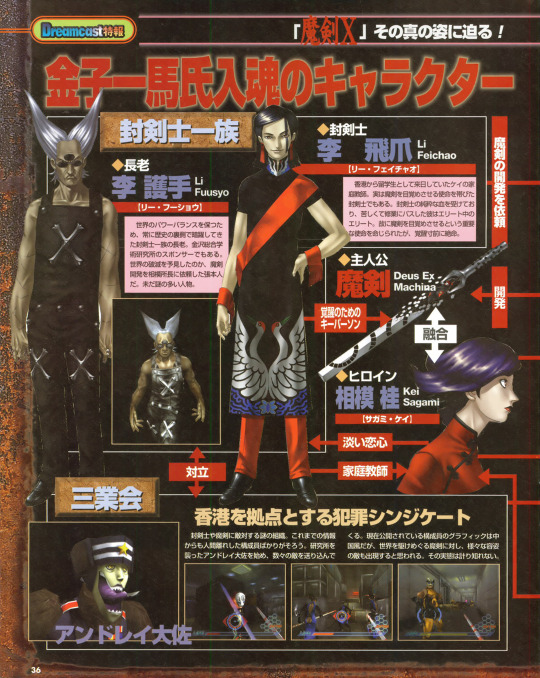
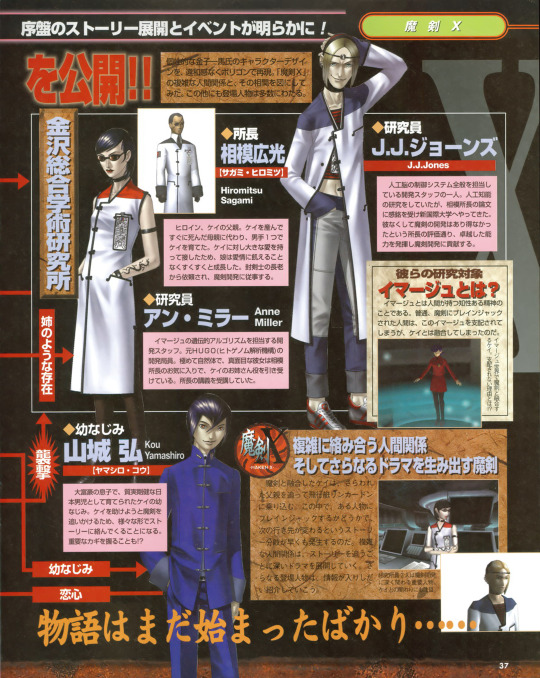
Maken X characters designs by Kazuma Kaneko in Dreamcast Magazine issues n°4-18 (1998-1999)
#maken x#gothic#character#design#kazuma kaneko#sega#dreamcast#dreamcast magazine#ad#print#issue#n°4#n°18#1998#1999
361 notes
·
View notes
Text
Hi there. I haven’t seen anyone make a full translation of the 50-minute The Making of SMT III: Nocturne documentary, so I did all the translations myself out of pure love for the game. I’m also a big fan of eirikr’s blog! Here’s the link and please share it if you’d like to:
youtube
This is incredible work! There have been attempts in the past that have stalled for one reason or another, but this is the first full translation that I’m aware of. Happy to spread the word.
398 notes
·
View notes
Text
A Missed Mystery: Who is Hanoun?

All credit for this discovery to @veskscans
The name of Daleth's fairy lover in smt2 (JP: アヌーン)has almost always been assumed to be correctly translated as "Hanoun", but what the heck is a Hanoun? This identity doesn't fit the scenario nor does it bring up anything but smt with a search. The culprit is probably old smt books that provide romanizations like these:
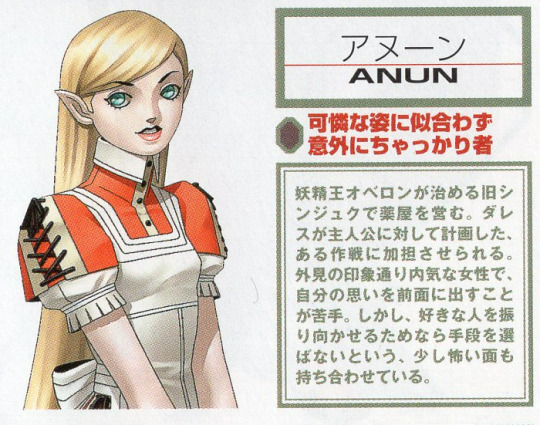
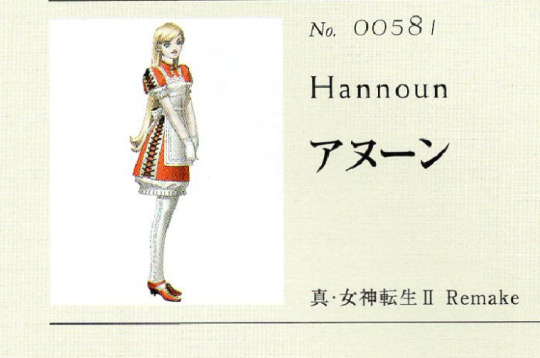
They make some sense considering アヌーン itself is pronounced "ah-noon", but we all know Cu Chulainn isn't really pronounced "koo koo lane ." So what gives?
The truth is they may just be romanization guesstimates for yet another being of Celtic provenance (specifically Welsh, as it turns out).
Vesk tracked down the following entry in Katharine Briggs' ever-relevant-to-smt Encyclopedia of Fairies (a confirmed atlus source):

GWRAGEDD ANNWN.
The entry gives the English phonetic pronunciation gwrageth anoon, which just so happens to be the same as the Japanese. The background of her being a lake maiden who falls in love with a mortal gives more depth to the smt2 scenario than we ever realized.
So, judging by her name in katakana, she should just be romanized as Annwn.
So far, her name has only ever appeared once in an English localized game: as a demon trader in Soul Hackers. Now that the real intention behind her is known, by the time we get to an smt2 remake or port, there will be no excuse for more "Hanoun."
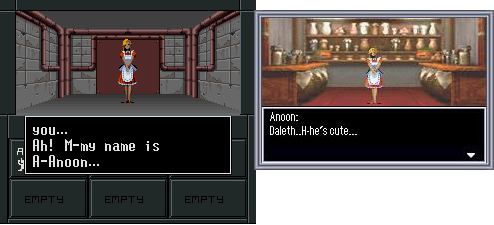
#shin megami tensei#megaten#kazuma kaneko#smt2#hanoun#annwn#daleth#アヌーン#GWRAGEDD ANNWN#welsh folklore#wales#Katharine Briggs#Encyclopedia of Fairies#mystery demons
90 notes
·
View notes
Text
Explaining the Origin of Megaten demons: ShikiOuji

I am sure that, if you played any Megaten game in the last 20 years or so, you ended up seeing this paper dude. His name is always stated as Shiki-Ouji, and he once shared the same design with the Demon called Shikigami.
The weird thing is that when researching Shikigami on my studies, i never found anything about this one so i put some detective work to find out about the origins of Shikiouji, the (yet another) dude who oftens repel physical damage in Megaten.
The creature is often describes in the series compendium as a powerful Shikigami, that only the most powerful Onmyoji could summon, and they have a vicious temperament.

When we talk about Shikigami, the first thing that comes to mind are paper dolls. This is no surprise, since Shikigami are summons Onmyoji binds to paper dolls or talismans, so they could interact with the physical world. This is also because paper is a very easy material to destroy, if things go south. Onmyoji are the equivalent of western sorcerer, that followed the Onmyōdō, a esoteric cosmology. It started in the 6th century in Japan as a divination practice, and evolved from there. I won't go into detail, because this is meant to be a short post. But materials about this practice are abundant on the internet.
The main concept concerning us here is the Shikigami. These are basically some kind of familiar, a spirit or demon if you want, the sorcerer could conjure to protect him or do his biding. The Cultural Alliance Brazil- Japan, which i already mentioned in other posts, states that:
''Shikigami can be Oni or demons, that should serve and protect an Onmyoji. Your abilities would be determined by the abilities of his master.
A Shikigami could assume the form of small animals, birds, etc... One Shikigami from a powerful Onmyoji could possess and control one animal. But only a real powerful Shikigami could possess a person.
When an Onmyoji is fighting another Onmyoji, they employ the use of their Shikigami. Some Onmyoji could spot the enemy Shikigami beforehand, and try to convert it to his side with magical powers. In this game, the converted Shikigami would come back to the old master, and attack with double the force. This pratice was called Shikigami Gaeshi.
Abe no Seimei is said to be the most powerful Onmyoji to ever exist. Some rumors say he had twelve Shikigami, while regular Onmyoji would rarely have more than one Shikigami at the same time.''
So, that is a rough definition of what a Shikigami is.
But, when researching this creature you would not be able to regularly find Shiki-ouji. The fastest method for him to appear, was the English Wikipedia article about Shikigami, which weirdly had this part about Shiki-ouji, but offered no source to it:

Having the kanji to Shikiouji, and some keywords, i found someone at Tumblr who asked the same question 6 years ago, in Eirikr's blog.
From there, Eirikr offered a link to a blog post writing about Izanagi Ryu Shikoku. Ryu Shikoku is an ancient folk religion and pratices from the Kochi prefecture. It is still practiced in the area to this day!
In this belief system there is the tradition of the Shiki-kui masks. Which.. bear a very uncanny resemblance to our paper guy, subject to this post:
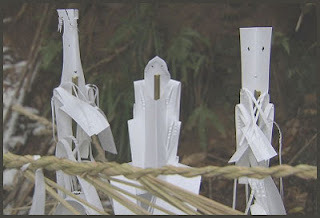
These masks would be hang above the place the ceremonies of the Izanagi Ryu take place. They would have magical powers that could repel evil spirits, and non believers from coming to the ceremony and disturbing it. They would also serve as talismans, or paper dolls, in a simmilar vein the regular Shikigami pop image you have in mind.
Since they are used to summon spirits, bind them, and as talismans, these creatures can be, technically called a Shikigami.
With this knowledge in hands, i went to the Japanese web. And sure enough, i found this site: The Nippon Foundation Library. It has an article detailing the paper talismans used by Izanagi No Ryu Onmyoji, and their meanings, powers, and also explained a bit about Shiki-Ouji!
Here is what they have to say: (Please be warned that i do not speak Japanese, and used machine translation. Any corrections are Welcome!)
Shikē Ōji… Shikē Ōji is a spiritual entity invoked by the taisa during prayers for the sick and the "toriwake" ritual to expel evil spirits causing illness or calamity. Its birth is described as abnormal, and due to its excessively violent power, it has no place to reside. Usually, it is sunk in the pond of Tendō-nanta, and summoned only when needed to guard ceremonies, to pray as the guardian deity of ceremonies, or as a prayer deity of Jumon no hakase. There seem to be several types of Shikē Ōji depending on their purpose, such as Takata no Ōji for toriwake, Gotai no Ōji for prayers for the sick, and Ōtaka-shiki for insect prayers. Additionally, talismans such as Sangoku Arashiki, Chimura San Ōji, and Sakago no Ōji are handed down, and it is inferred that they were used according to the content of the prayers, although many details of their usage are unknown.
Using the powerful Shikē Ōji against humans becomes a curse. In Kochi Prefecture, "hitting a ceremony" is widely used to curse people. Many people use this term without understanding its original meaning. "Hitting a ceremony" refers to attacking someone using Shikē Ōji. While Shikē Ōji can benefit people if used for good, it can harm them if used for evil.
Talismans of Shikē Ōji, possessing such terrifying power, often have several incisions on them, each containing twelve notches, giving them a rough impression. However, unlike talismans found in mountains and rivers, they do not seem to have incisions for eyes or mouths. In this regard, they are closer to the cutting style of talismans for house gods and sacred gods. Here, one can sense the emphasis on the powerful nature of Shikē Ōji's talismans while also distinguishing them from strange monsters.
So, as you can see there is some key information about the creature here. But the most important ones:
1- It is bind to a talisman, just like other Shikigami. The text here explains it is a paper talisman with notches, just like regular ones used in religious ceremonies.
2-It has a powerful and violent nature, just like the compendium often indicates in Megaten games. It seems hard to tame and use properly without getting hurt.
3-Shiki-Ouji can be powerful and violent, but it seems they dislike being used to hurt people. Instead, they are better employed to use their magic to other deeds. However if you still use them in that regard, they will most likely curse you.
4-Their talismans have twelve notches, no incision for eyes and mouth due to their aggressive nature.
I am sure that, if we follow this trail we will find many more sources. Going by key words i found in this text, i found many other sites and books, but since i have no time now to fall a rabbit hole, nor do i speak Japanese... That is it, i think this is a satisfactory answer to where this Megaten Demon came from!
The real forms of Shiki-Ouji
The last thing in want to talk about, is Shiki-Ouji real appearance. Since we have a seemingly wrong impression of they in Megaten, since Kaneko took some artistic freedoms.
First and foremost: From the few things i studies about Shikigami, we know they do not have a real physical form. The paper talismans are just a way to give them physical form. But it was incredibly hard to find a Shiki-Ouji talisman, which was weird because it was so distinguishable. The main reason being that: Shiki-Ouji seems not to be believed to be easy or safe to summon, and also their talismans would be destroyed asap after use.
But with the description i got, it would be this one that matches it the most:
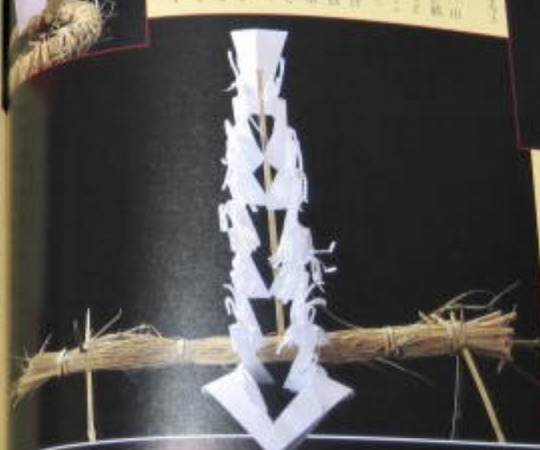
No eyes, or mouth. Twelve Notches, six from each side, and some incisions. Very similar to a regular talisman found in other types of ceremony. Just as the text suggested.
I got this picture from this book:
Tosa, Monobe Village: Shapes of the Gods
Monoba being the village where most of these rituals came from. The book is from 1999, and contains many pictures of actual talismans.
You can see that, aside from the head shape, Kaneko took some freedom with this design. The sources state that Shikiouji talismans should not have a face, nor limbs, since it was too powerful, and should have 12 notches. For some reason, Kaneko drew it in a human-like form, but the face still resembled the Shiki-kui masks. The earlier design of the demon was even more closely resembling the masks:


Shiki-ouji earlier design from Devil Summoner (1996). It was later repurposed as the demon Shikigami. It is almost an exact match to this talisman. I can not however identify the original source.
Shiki-Ouji current design by itself could have been based on this one talisman in specific, at least some parts of it like the head with horned-shaped appendages:

It was sourced by the National Museum of Japanese History, but the post went down. The low quality image of the talisman can still be seen on google, but the link is dead, unfortunately. It seems that this item is in possession of the Museum in Japan. Kaneko could have seen it in pictures, or in person. This one seems NOT to be displaying a Shiki-Ouji thought.
Maybe the Kaneko take is that Shiki-Ouji was summoned with limbs, and facial features and became much more stronger as a result? We may never know...
And finally there is also an occult book that i found in Amazon Japan that is called: Exploring Izanagi No Ryu: ShikiOuji.
It is supposedly a manual on how to practice Izanagi no Ryu, and magics. I could not find the book online, just the summary. But it mentioned nothing about Shiki-Ouji. Probably has some sort of tutorial to summon it, in fact i was able to find many of those tutorials on the Japanese web.

Now, that is it. I think this puts to rest a little bit of mystery involving the origins of this specific demon. Kaneko sure took some freedoms, but it is still one of the more popular and recognizable characters in the series.
Final considerations:
This most likely is the answer to its origin, but i am not some sort of owner of all truths, so feel free to correct me in anything i said wrong. I am still an amateur scholar, and even if i do know a lot about mythology and ancient religions because i read many books and study a lot of hours of my days, i am by no means a specialist in Japanese Mythology specifically, specially Shikigami practices. The reason is that, i find it very difficult and time consuming to research Japanese sources, since i do not speak Japanese. I will one day, try my best since there are a lot of good Yokai to cover in future Scientific Papers.
I can, however, guarantee that i did my best in a deep search!
And i have spent a lot of time looking through pictures of Shikigami talismans, and i found some really cute. Like this one. What a whimsical little fella...

#shin megami tensei#atlus#kazuma kaneko#blazescompendium#megaten#mythology#japanese folklore#japanese mythology#shikigami#megami tensei#smt
59 notes
·
View notes
Text
Persona Sketches by Kazuma Kaneko
Long post today. I recently picked up Megami Ibunroku Persona Club, a fan book that includes 12 of Kaneko’s rough sketches for the game’s original Persona designs. Here’s scans of them that I did over a couple of days, they were printed tiny so these were the best that I could get (there are also textless versions in the link).
https://drive.google.com/drive/folders/1waKTLvlDJb3DJAHWOUSgYVUEyXYiBiUO?usp=share_link
I’ll provide translated commentary too... translated by me, so it might not be that great. I’ll give my own input underneath as well, but I won’t be translating the handwriting on the art. It’s hard to read, for one, and it just outlines basic features and colours, likely for sprite artists to use as reference.
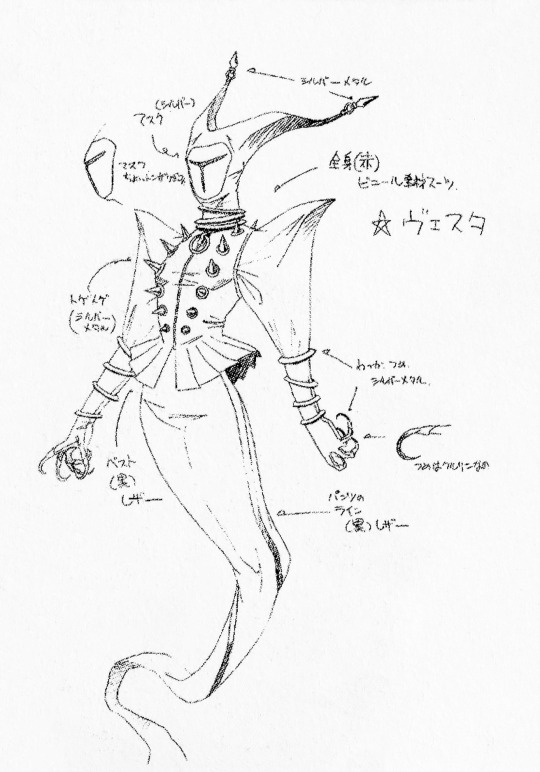
‘Vesta, the goddess of hearths in Roman mythology. The shape of her hat is somewhat reminiscent of a jester's, and her lack of legs is a distinguishing characteristic. Her entire body is covered in leather’.
Vesta also reappears in P2 EP, and is Yukino Mayuzumi's initial Persona in both games. You can also spot Vesta behind some text in the Persona Original Soundtrack booklet here.

‘Gozu-Tennō, deity of the Gion Shrine in Kyoto. According to some legends, he his sometimes equated with Susanō. The horns extending from his mask and intertwining with each-other are quite impactful’.
The cape is meant to be coloured red... definitely inspired by Spawn. Also in the Persona Original Soundtrack booklet, here.
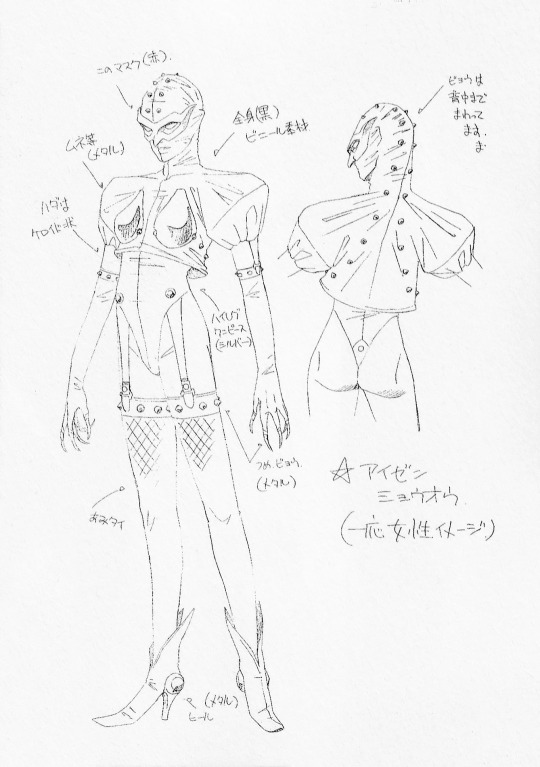
‘Aizen-Myōō, the love deity of Esoteric Buddhism. She can transform sentient beings' lustful desires and troubles into spiritual enlightenment. Buddhist statues often depict Aizen-Myōō with the face of a scary-looking man, but the female image used here is perhaps the most human-like’.
Kei Nanjo's initial Persona in P1. Also in P2 EP, with a couple of additions to her design. Aside from her heels and long, black coverings, it’s essentially P1′s design replicated underneath.

“Lakshmi, the goddess of beauty in Hindu mythology. The protruding back of the head looks a bit like an alien. The rubber material used in these designs comes from Kaneko-san's favourite clothes”.
Not in P2 IS, but she does reappear as a sprite in P2 EP, with different colours. The head was definitely inspired by the Xenomorph from Alien.


“Kali, the goddess of war in Hindu mythology. The protruding design of her breasts is quite striking, but their bellow-like shapes are less noticeable in-game”.
Also seen controlling Maki in the 'Dolls' artwork.
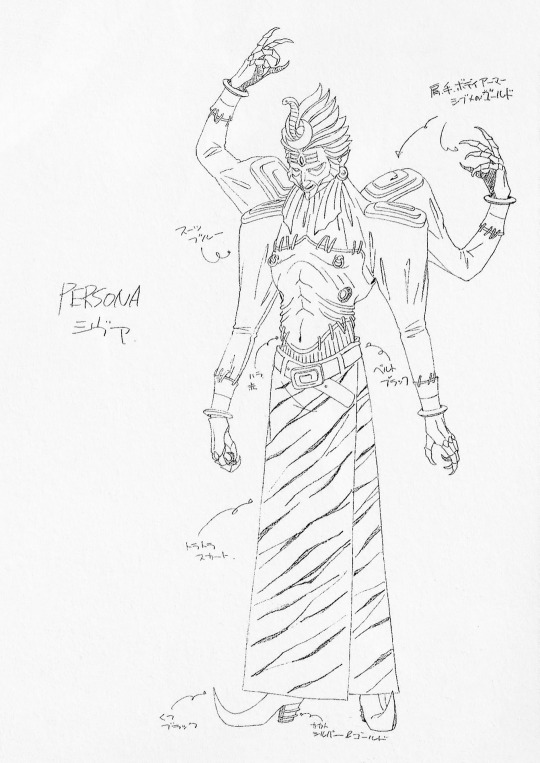
“Shiva, the god of destruction in Hindu mythology. Both Shiva and Kali had different rough designs than the versions shown on page 4”.
The art on page 4 is just the finalised art of Shiva and Kali. The designs are the same as they are in the sketches, I think they just meant the art is different.

“Garuda, the bird god of Hindu mythology. The cape, pose and mask are reminiscent of old-fashioned anime”.
The anime in question seems to be ‘Science Ninja Team Gatchaman’ from 1972. Thanks to @RustyVanBurace on Twitter for pointing this out. Notice the G on their belts, which I suppose stands for Gatchaman (I haven’t watched it). Garuda also has the G on his stomach, but in this case, I guess it just stands for Garuda, lol.


“Vishnu, the main deity and god of creation in Hindu mythology. He has appeared in commercials and other media, so you might recognise his face, but few people actually identify him as Vishnu”.
Here’s a link to the commercials in question. He probably has the most art of any Persona in the game, which might be why the only text in the art is his name. There might have already been public material that the sprite artists could have used for reference, or maybe this art was done earlier on, and Kaneko didn’t think about outlining colours just yet.
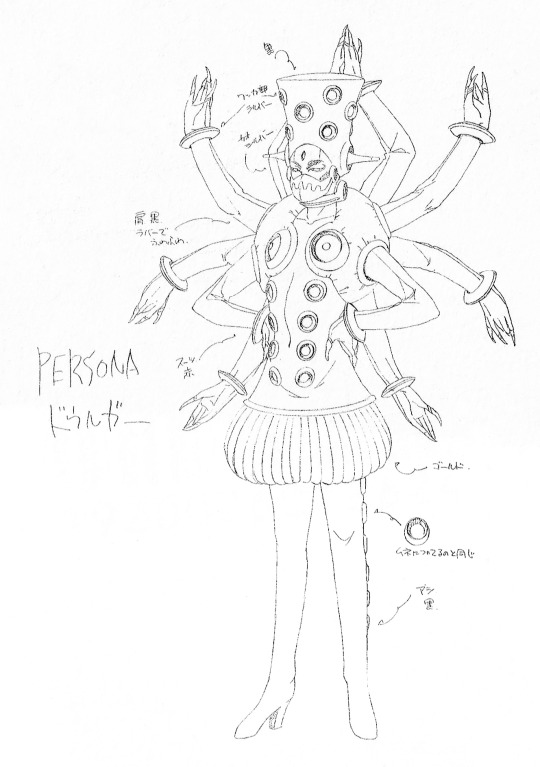
"Durga, an incarnation of Kali. Her hat-like mask and the design of her clothes, which seem to be made of a rubber material, make for one of the most daring outfits in the series”.
Yukino Mayuzumi's ultimate persona in both P1 and P2 IS. If anything, it got even more daring in IS, with robo-hands cupping her boobies and being used as high heels.

"Shōmen-Kongō is prominent god in the Kōshin cult. Kōshin-tō monuments can often be found along roadsides. He is the initial persona of the protagonist, who you will see many times during awakening scenes. He has somewhat of a Tokusatsu design".
Better known as Seimen-Kongō. The name means 'Blue-Faced Vajra-Yakṣa'. I know next to little about any Kōshin stuff, so don’t trust my translation for this one particularly. Sometimes he’s depicted with three monkeys, as seen below. The monkeys are the origin of the phrase “see no evil, hear no evil, speak no evil”, which is why one has a mask over their eyes, another has a mask over their mouth, and the last one has... headphones, lol. Shōmen-Kongō has a tail in the art below, but not in the rough art.
On the Tokusatsu note from that last sentence - I don’t know enough about Tokusatsu to guess what it’s from, but the face, including the lack of mouth, looks like a mask in particular. The yellow lines going down his body also look like something from Ultraman.
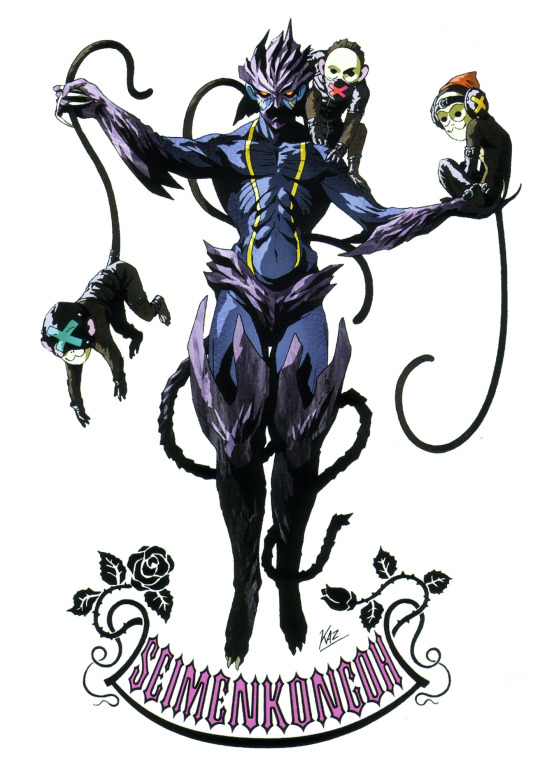
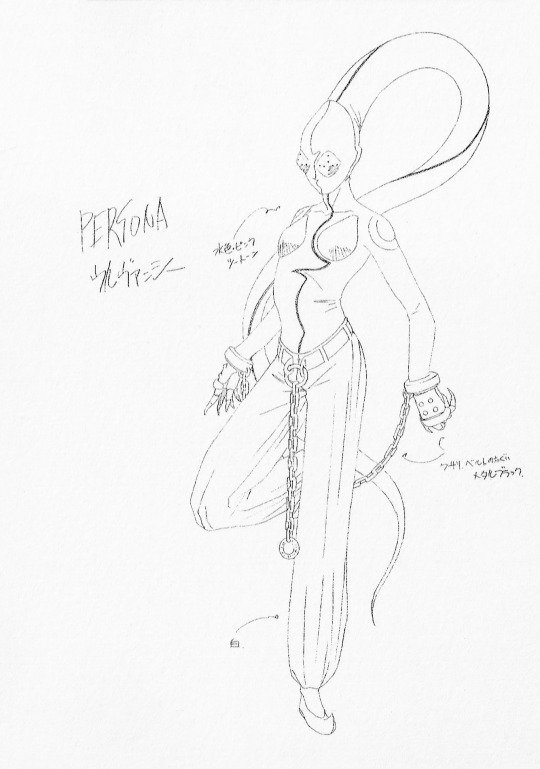
"Urvashi is a prominent Apsara (celestial nymph) in Hindu mythology. Her design strongly expresses the dancing aspect of the Apsaras”.
Cool design, but she’s not all that notable in-game. She’s meant to be the ‘main’ Apsara, so it’s surprising that the only other game she appeared in was Majin Tensei II.

"Hanuman, the heroic god of Hindu mythology and the original form of Qitian Dasheng. The only motif remaining from the monkey figure is his tail. The shape of his head is quite familiar...”
Last one! AKA Sun Wukong, Seiten Taisei, Son Gokū, etc., you know the drill. The shape of his head is quite familiar indeed, since it comes from Ultraman. Ultraseven, in particular. Also notice the similar plated design on the neck and shoulders. Thank you AtmaFlare for finding this dude (or on Twitter, @atmaflare).
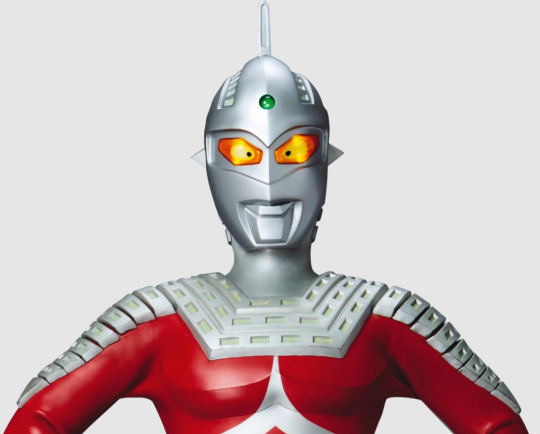
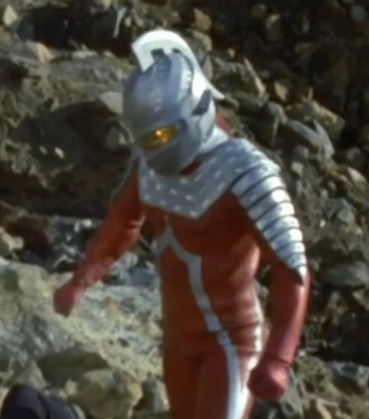
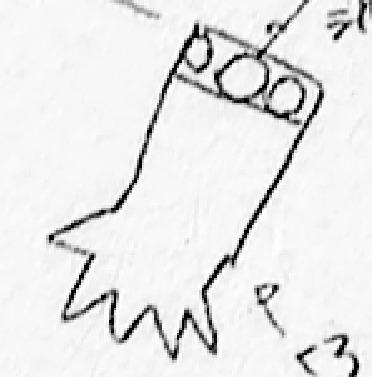
^ Is this Kaneko’s magnum opus?
#persona#persona 2#persona 3#persona 4#persona 5#megami ibunroku persona#kazuma kaneko#megaten#megami tensei#smt#shin megami tensei
454 notes
·
View notes
Text
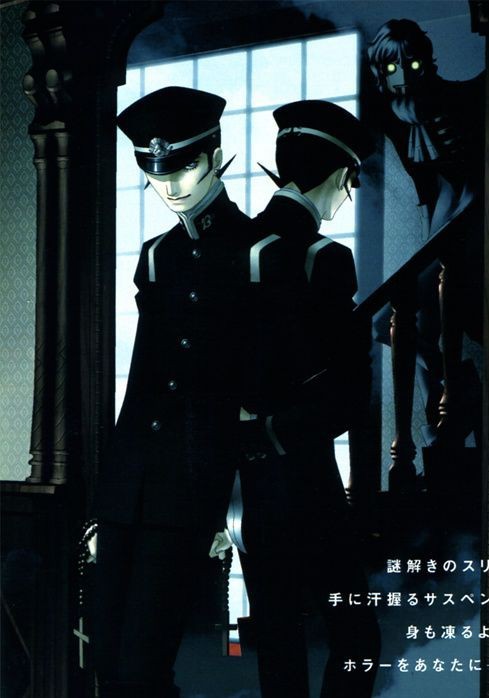

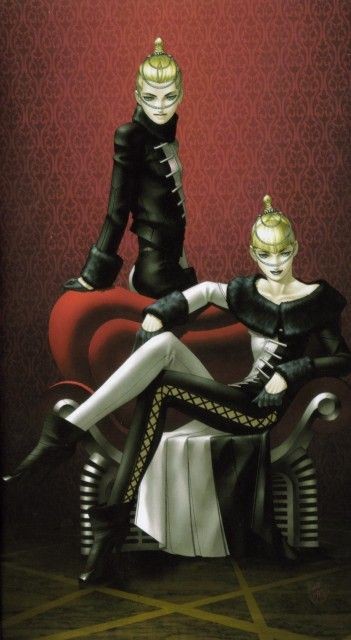

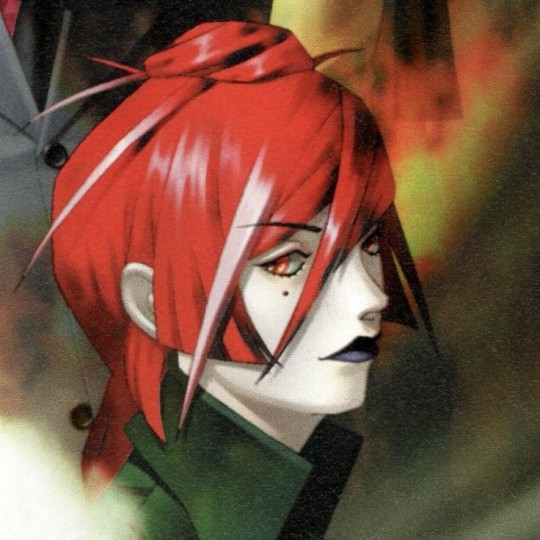
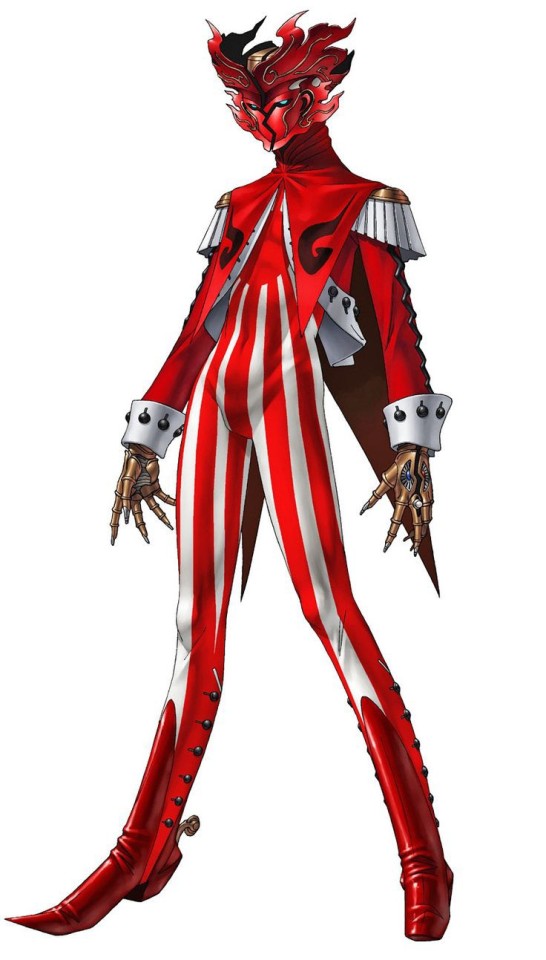
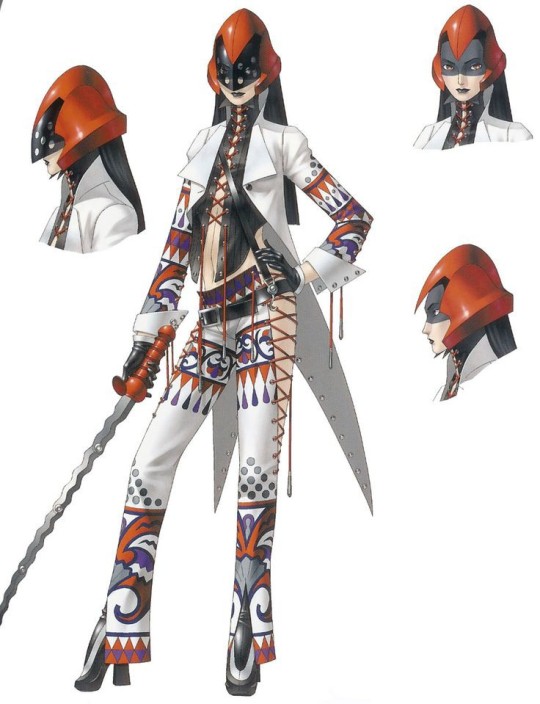

oh to be a character designed by kazuma kaneko
58 notes
·
View notes
